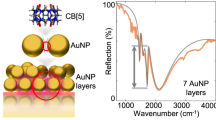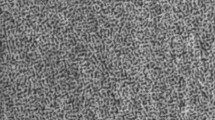Abstract
The lack of symmetry between electric and magnetic charges, a fundamental consequence of the small value of the fine-structure constant1, is directly related to the weakness of magnetic effects in optical materials2,3. Properly tailored plasmonic nanoclusters have been proposed recently to induce artificial optical magnetism4,5,6,7 based on the principle that magnetic effects are indistinguishable from specific forms of spatial dispersion of permittivity at optical frequencies1. In a different context, plasmonic Fano resonances have generated a great deal of interest, particularly for use in sensing applications that benefit from sharp spectral features and extreme field localization8,9,10,11,12. In the absence of natural magnetism, optical Fano resonances have so far been based on purely electric effects. In this Letter, we demonstrate that a subwavelength plasmonic metamolecule consisting of four closely spaced gold nanoparticles supports a strong magnetic response coupled to a broad electric resonance. Small structural asymmetries in the assembled nanoring enable the interaction between electric and magnetic modes, leading to the first observation of a magnetic-based Fano scattering resonance at optical frequencies. Our findings are supported by excellent agreement with simulations and analytical calculations, and represent an important step towards the quest for artificial magnetism and negative refractive index metamaterials at optical frequencies13,14,15.
This is a preview of subscription content, access via your institution
Access options
Subscribe to this journal
Receive 12 print issues and online access
$259.00 per year
only $21.58 per issue
Buy this article
- Purchase on Springer Link
- Instant access to full article PDF
Prices may be subject to local taxes which are calculated during checkout





Similar content being viewed by others
Change history
01 February 2013
In the version of this Letter originally published online, the surname of the fifth author should have read 'Hartsfield'. This error has been corrected in the HTML and PDF versions of the Letter.
References
Landau, L. D. & Lifshitz, E. M. Electrodynamics of Continuous Media (Pergamon, 1960).
Alu, A. & Engheta, N. The quest for magnetic plasmons at optical frequencies. Opt. Express 17, 5723–5730 (2009).
Merlin, R. Metamaterials and the Landau–Lifshitz permeability argument: large permittivity begets high-frequency magnetism. Proc. Natl Acad. Sci. USA 106, 1693–1698 (2009).
Shvets, G. & Urzhumov, Y. A. Engineering the electromagnetic properties of periodic nanostructures using electrostatic resonances. Phys. Rev. Lett. 93, 243902 (2004).
Liu, N., Fu, L., Kaiser, S., Schweizer, H. & Giessen, H. Plasmonic building blocks for magnetic molecules in three-dimensional optical metamaterials. Adv. Mater. 20, 3859–3865 (2008).
Alù, A., Salandrino, A. & Engheta, N. Negative effective permeability and left-handed materials at optical frequencies. Opt. Express 14, 1557–1567 (2006).
Podolskiy, V., Sarychev, A. & Shalaev, V. Plasmon modes and negative refraction in metal nanowire composites. Opt. Express 11, 735–745 (2003).
Luk'yanchuk, B. et al. The Fano resonance in plasmonic nanostructures and metamaterials. Nature Mater. 9, 707–715 (2010).
Hao, F. et al. Symmetry breaking in plasmonic nanocavities: subradiant LSPR sensing and a tunable Fano resonance. Nano Lett. 8, 3983–3988 (2008).
Verellen, N. et al. Fano resonances in individual coherent plasmonic nanocavities. Nano Lett. 9, 1663–1667 (2009).
Francescato, Y., Giannini, V. & Maier, S. A. Plasmonic systems unveiled by Fano resonances. ACS Nano 6, 1830–1838 (2012).
Brown, L. V., Sobhani, H., Lassiter, J. B., Nordlander, P. & Halas, N. J. Heterodimers: plasmonic properties of mismatched nanoparticle pairs. ACS Nano 4, 819–832 (2010).
Yuan, H-K. et al. A negative permeability material at red light. Opt. Express 15, 1076–1083 (2007).
Shalaev, V. M. Optical negative-index metamaterials. Nature Photon. 1, 41–48 (2007).
Pendry, J. B. Negative refraction makes a perfect lens. Phys. Rev. Lett. 85, 3966–3969 (2000).
Pendry, J. B., Holden, A. J., Robbins, D. J. & Stewart, W. J. Magnetism from conductors and enhanced nonlinear phenomena. IEEE Trans. Microwave Theor. Tech. 47, 2075–2084 (1999).
Zhou, J. et al. Saturation of the magnetic response of split-ring resonators at optical frequencies. Phys. Rev. Lett. 95, 223902 (2005).
Alù, A. & Engheta, N. Dynamical theory of artificial optical magnetism produced by rings of plasmonic nanoparticles. Phys. Rev. B 78, 085112 (2008).
Fan, J. A. et al. Fano-like interference in self-assembled plasmonic quadrumer clusters. Nano Lett. 10, 4680–4685 (2010).
Fan, J. A. et al. DNA-enabled self-assembly of plasmonic nanoclusters. Nano Lett. 11, 4859–4864 (2011).
Fan, J. A. et al. Self-assembled plasmonic nanoparticle clusters. Science 328, 1135–1138 (2010).
Sheikholeslami, S. N., García-Etxarri, A. & Dionne, J. A. Controlling the interplay of electric and magnetic modes via Fano-like plasmon resonances. Nano Lett. 11, 3927–3934 (2011).
Baur, C. et al. Nanoparticle manipulation by mechanical pushing: underlying phenomena and real-time monitoring. Nanotechnology 9, 360–364 (1998).
Kim, S., Shafiei, F., Ratchford, D. & Li, X. Q. Controlled AFM manipulation of small nanoparticles and assembly of hybrid nanostructures. Nanotechnology 22, 115301 (2011).
Junno, T., Deppert, K., Montelius, L. & Samuelson, L. Controlled manipulation of nanoparticles with an atomic force microscope. Appl. Phys. Lett. 66, 3627–3629 (1995).
Prodan, E., Radloff, C., Halas, N. J. & Nordlander, P. A hybridization model for the plasmon response of complex nanostructures. Science 302, 419–422 (2003).
Esteban, R., Borisov, A. G., Nordlander, P. & Aizpurua, J. Bridging quantum and classical plasmonics with a quantum-corrected model. Nature Commun. 3, 825 (2012).
Papas, C. H. Theory of Electromagnetic Wave Propagation (Dover, 1988).
Acknowledgements
The authors thank Chihhui Wu and Jiming Bao for helpful discussions. This work was supported in part by the US Army Research Laboratory and the US Army Research Office (W911NF-11-1-0447), the National Science Foundation (NSF; DMR-0747822), the Office of Naval Research (ONR; N00014-08-1-0745), the Air force Office of Scientific Research (AFOSR; FA9550-10-1-0022), the Welch Foundation (F-1662), the Alfred P. Sloan Foundation, AFOSR with the Young Investigator Program (YIP) (award no. FA9550-11-1-0009) and an ONR MURI grant (no. N00014-10-1-0942).
Author information
Authors and Affiliations
Contributions
F.S. performed the experiments. F.M. and K.L. conducted the calculations and theoretical modelling. T.H. and X-X.L. facilitated the experimental and theoretical work, respectively. A.A and X.L. supervised the project. All authors discussed the results and commented on the paper.
Corresponding authors
Supplementary information
Supplementary information
Supplementary information (PDF 978 kb)
Rights and permissions
About this article
Cite this article
Shafiei, F., Monticone, F., Le, K. et al. A subwavelength plasmonic metamolecule exhibiting magnetic-based optical Fano resonance. Nature Nanotech 8, 95–99 (2013). https://doi.org/10.1038/nnano.2012.249
Received:
Accepted:
Published:
Issue Date:
DOI: https://doi.org/10.1038/nnano.2012.249
This article is cited by
-
Bright single-nanocrystal upconversion at sub 0.5 W cm−2 irradiance via coupling to single nanocavity mode
Nature Photonics (2023)
-
Acoustic Fano-like resonance phenomenon based local resonance generated by soft material cylinder
Applied Physics A (2023)
-
A Metamaterial Inspired Low-Scattering Electric Quadrupole Antenna
Wireless Personal Communications (2023)
-
Enantioselective sensing by collective circular dichroism
Nature (2022)
-
Empowering magnetic strong coupling and its application for nonlinear refractive index sensing
Nano Research (2022)



